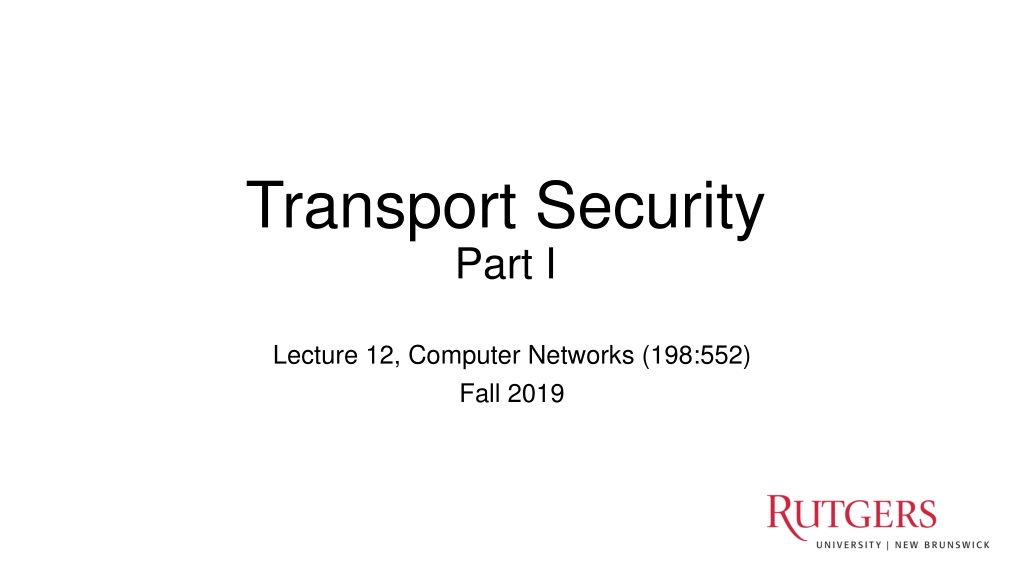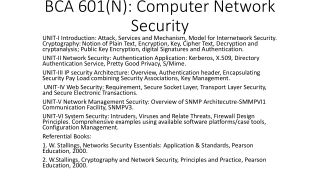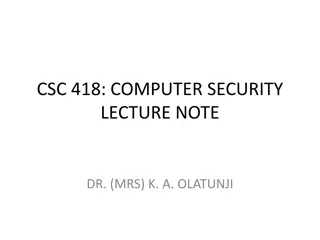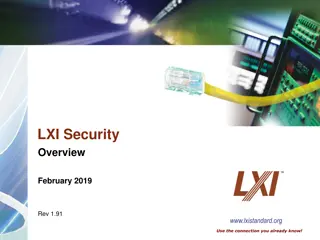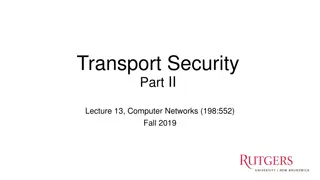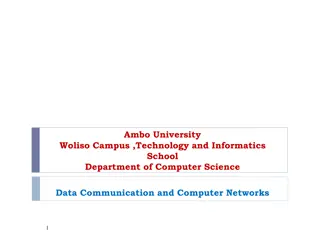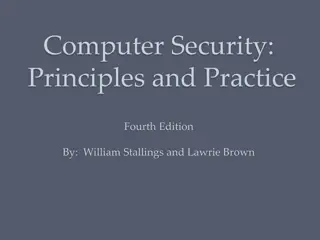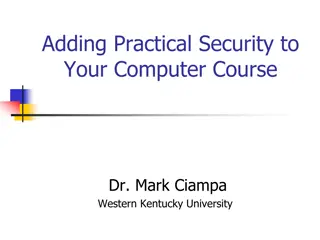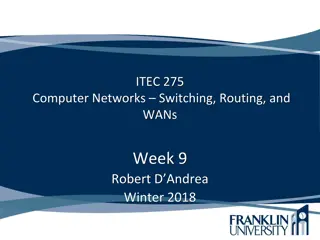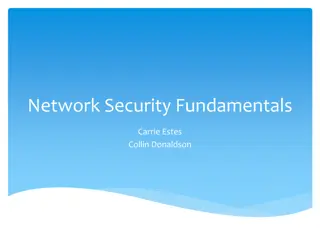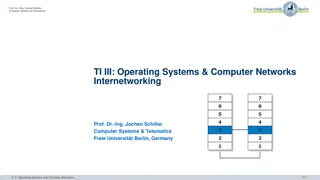Understanding Network Security Fundamentals in Computer Networks
Explore the importance of network security in Computer Networks, focusing on key aspects like confidentiality, integrity, authentication, and non-repudiation. Learn about common threats, such as eavesdropping, impersonation, hijacking, and denial of service attacks, and the role of cryptography in ensuring confidentiality. Follow along with the story of Alice, Bob, and Trudy to understand secure communication challenges in network environments.
Download Presentation

Please find below an Image/Link to download the presentation.
The content on the website is provided AS IS for your information and personal use only. It may not be sold, licensed, or shared on other websites without obtaining consent from the author. Download presentation by click this link. If you encounter any issues during the download, it is possible that the publisher has removed the file from their server.
E N D
Presentation Transcript
Transport Security Part I Lecture 12, Computer Networks (198:552) Fall 2019
Why security? Malicious people share your network People who want to snoop, corrupt, destroy, pretend, steal, Problem made more severe as Internet becomes more commercialized Active and passive attacks
Key aspects of network security confidentiality: only sender, intended receiver should understand message contents sender encrypts message receiver decrypts message integrity: sender, receiver want to ensure message not altered (in transit, or afterwards) without detection authentication: sender, receiver want to confirm identity of each other non-repudiation: Once someone sends a message, or conducts a transaction, she can t later deny the contents of that message
Friends and enemies: Alice, Bob, Trudy well-known in network security world Bob and Alice want to communicate securely Trudy (intruder) may intercept, delete, add messages Alice Bob data, control messages channel secure sender ssecure receiver data data Trudy
Who might Bob and Alice be? Real humans Web browser/server for electronic transactions (e.g., on-line purchases) on-line banking client/server DNS servers routers exchanging routing table updates
What can bad actors do? A lot! eavesdrop: intercept messages actively insert messages into connection impersonation: can fake (spoof) source address in packet (or any field in packet) hijacking: take over ongoing connection by removing sender or receiver, inserting itself in place denial of service: prevent service from being used by others (e.g., by overloading resources)
Confidentiality Cryptography: preventing adversaries from reading private messages
Cryptography: Terminology Alice s encryption key Bob s decryption key KA KB encryption algorithm decryption algorithm ciphertext plaintext, m plaintext En/decryption algorithms are also called ciphers. m plaintext message c = KA(m), KA(m) ciphertext, encrypted with key KA m = KB(c), KB(c) decrypted plaintext with key KB Want: m = KB(KA(m)) Want: KA(m) to be uncorrelated with m
Cryptography: Algorithms and Keys Cryptography requires both an en-/decryption algorithm and keys Key is a string known only to Alice and Bob, which controls how algorithm works Algorithm should be public and known to all Inspires trust that the algorithm works Keys Should be long enough to prevent easy breaking of the encryption Should be short enough to keep algorithm efficient Typical key lengths: 56-bit, 128-bit, 256-bit, 512-bit
Symmetric key cryptography KS KS encryption algorithm decryption algorithm ciphertext plaintext plaintext message, m KS(m) m = KS(KS(m)) Symmetric keys: Bob and Alice share same (symmetric) key: S Main techniques of symmetric key cryptography: Substitutionand Permutation Q: how do Bob and Alice agree on key value?
How to agree on a shared secret key? In reality: two parties may meet in person or communicate out of band to exchange shared key But communicating parties may never meet in person Example: An online retailer and customer Much more common for a network What if the shared secret is stolen? All secret communications can now be decrypted and are visible Including earlier ones that were encrypted using that secret How to communicate without necessitating key exchange? Public key cryptography
Public Key Cryptography Sender and receiver do not share secret key publicencryption key known toall private decryption key known only to the receiver
Public key cryptography (eg: RSA) + Bob s public key K B - Bob s private key K B encryption algorithm decryption algorithm plaintext message m = K (K (m)) B ciphertext K (m) B plaintext message, m + - + B
Diffie Hellman Merkle key exchange Alice and Bob agree on a modulus p and base g Is the common key computed by Alice and Bob the same? Alice chooses secret a, sends bob A = ga mod p In what sense is D-H-M key exchange secure? Bob chooses secret b, sends bob B = gb mob p Alice computes Ba mod p Bob computes Ab mod p
Public vs. Symmetric key crypto Public key crypto Symmetric key crypto Expensive to encrypt using just modular exponentiation operations Encryption and decryption are fast But need to solve the key exchange problem No need to exchange keys
Crypto in practice: session keys Use public key crypto or key exchange to agree on a symmetric session key EKpub,Jeff(Sally,RSally) EKpub,Sally(RSally, RJeff, KS) Sally Jeff Use symmetric key to protect the rest of the session efficiently EKS(RJeff)
Integrity Did messages get across without tampering?
Message digests large message m H: Hash Function Can we ensure that a receiver can detect message tampering? H(m) Cryptographic hash function properties: Easy to calculate Produces fixed-size msg digest (fingerprint) Hard to reverse: given msg digest x, computationally infeasible to find m such that x = H(m) Or another m such that H(m) = H(m ) Idea:fixed-length, easy- to- compute digital fingerprint of a message apply hash function H to m, get fixed size message digest, H(m).
Using message digests for integrity s s = shared secret message message s message H( ) Internet compare H( ) Verifies message integrity Requires a secret shared key No encryption
Message digest algorithms You ll see the term MAC or Message Authentication Codes I find it confusing (medium access); I will avoid using it. MD5 hash function widely used (RFC 1321) computes 128-bit message digest in 4-step process. arbitrary 128-bit string x, appears difficult to construct msg m whose MD5 hash is equal to x SHA-1 is also used US standard [NIST, FIPS PUB 180-1] 160-bit message digest
Digital signatures Cryptographic technique analogous to handwritten signatures: sender (Bob) digitally signs document, establishing he is document owner/creator. verifiable, nonforgeable:recipient (Alice) can prove to someone that Bob, and no one else (including Alice), must have signed document
Digital signatures simple digital signature for message m: Bob signs m by encrypting with his private key KB, creating signed message, KB(m) - - - -(m) Bob s private key Bob s message, m K B m,K B Dear Alice Bob s message, m, signed (encrypted) with his private key Public key encryption algorithm Oh, how I have missed you. I think of you all the time! (blah blah blah) Bob
Authentication How do I know you are who you say you are?
Authentication using public key crypto Idea: Use nonce and public key cryptography I am Alice Bob computes (K (R)) = R A K A and knows only Alice could have the private key, that encrypted R such that (K (R)) = R A - + R - K (R) A send me your public key + K A - + K A
Security hole -- if you ask for public keys! man (or woman) in the middle attack: Trudy poses as Alice (to Bob) and as Bob (to Alice) I am Alice I am Alice R - K (R) T R Send me your public key - K + K (R) A T Send me your public key K + A + K (m) T Trudy gets - + T m = K (K (m)) sends m to Alice encrypted with Alice s public key + T K (m) A - + A m = K (K (m)) A
Certification authorities certification authority (CA): binds public key to particular entity, E. E (person, router) registers its public key with CA. E provides proof of identity to CA. CA creates certificate binding E to its public key. certificate containing E s public key digitally signed by CA CA says this is E s public key digital signature (encrypt) Bob s public key K B + K B + CA key K CA certificate for Bob s public key, signed by CA - private Bob s identifying information
Certification authorities When Alice wants Bob s public key: gets Bob s certificate (from Bob or elsewhere). apply CA s public key to Bob s certificate, get Bob s public key digital signature (decrypt) Bob s public key + K B + K B CA + public key K CA
